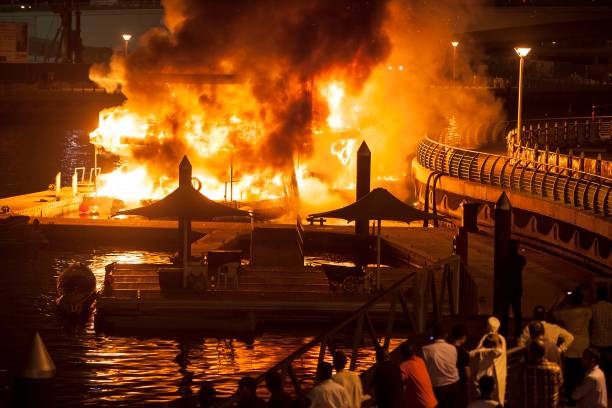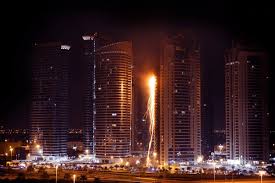Dubai Marina Fire : Late one June night, the usually serene skyline of Dubai Marina was pierced by orange flickers and thick, rolling smoke. A high-rise residential tower erupted in flames, triggering a massive emergency response that saw thousands evacuated and lives held in suspense. Here’s a carefully chronicled account of what unfolded—and how the community rallied to respond.
(Dubai Marina Fire)From Stillness to Alarm:
Just past 9:30 PM, residents in the Marina Pinnacle tower—also called Tiger Tower—were jolted awake by the acrid scent of smoke. One resident on the 49th floor described it best: “I woke up after smelling pungent smoke… we hurriedly went down the building in our pajamas”.
Within minutes, multiple reports placed the fire at a high floor—likely between the 60th and 67th levels—where flames and smoke billowed into the sky .
Massive Response, Swift Evacuation(Dubai Marina Fire)
Dubai Civil Defence sprang into action. Fire engines, ambulances, and rescue personnel surrounded the 67‑storey building. Over the next six hours, firefighters engaged in a grueling battle, finally bringing the fire under control in the early morning hours .
All 3,820 residents living across 764 apartments were evacuated safely—remarkably, there were zero injuries. Many were assisting with children, pets, and elderly family members as they waited on the street.
Tram services between Dubai Marina and Palm Jumeirah were halted to allow emergency vehicles to operate smoothly.
First-Person Accounts (Dubai Marina Fire)
Residents’ reflections bring the incident into sharp focus:
- One recounting sharing: “I was on the 24th floor with my wife when we smelled something burning around 9:45 pm… security only told us to leave when we called them”.
- Another high‑floor tenant described an eerie gaze from above, with stairwells thick in smoke, forcing them to use the elevator—a rare decision in fire emergencies.
The shared sentiment was clear: shock, fear, and immense relief that the alarm system and evacuation protocols worked when every second counted.
Community Support and Temporary Shelter
Evacuees found refuge in neighboring buildings and local hotels. Princess Tower opened its 97th floor, and hotel chains like Marriott provided accommodation, aiding families affected.
The broader Dubai community rose with empathy. Businesses such as Café Martinez and Sumo Sushi & Bento served free meals and drinks to displaced residents. Some were offered hotel stays for days to ease the shock.
Cooling Efforts & Fire Control
By early Saturday, firefighters had extinguished the main blaze. Though smoke continued to linger, it was primarily from cooling and containment tasks.
Specialized units worked to ensure the fire did not reignite—a danger in high-rise incidents—by monitoring hotspots across upper floors.

Piecing Together the Cause
At the time of reporting, authorities had not released a definitive cause. However, early observations suggest the fire began in the upper residential sector. Investigators, including the Dubai Civil Defence and Dubai Media Office, combed through CCTV and structural elements to assess cladding, wiring, and safety compliance.
High-rises in the Marina district have faced previous fires—The Torch (2015, 2017, 2019), Sulafa Tower (2016, Feb 2025), Zen Tower (2018)—some ignited by cladding or balcony issues, though thankfully without casualties. These past incidents have prompted stricter building regulations and response protocols.
Fire Safety — An Ongoing Battle
High-rise living demands rigorous adherence to safety norms. Following earlier tower blazes, Dubai Civil Defence accelerated its “30-Second Response” project—to ensure firefighting units reach emergency calls within half a minute. Officials claim this standard is met in 80% of cases with response times under eight minutes.
However, recurrent fires continue
Leadership & Public Reactions
Senior figures expressed calm confidence in the response:
- Dubai Civil Defence described the evacuation as “prioritising health and safety throughout the operation”.
- Rescue teams emphasized inter-agency coordination that ensured a smooth process—even under smoke-choked conditions.
Social media and local forums lit up with solidarity: from offers of spare rooms to vocal appreciation of the emergency services’ swift action.
Lessons Learned & What Comes Next
- Prompt evacuation and clear alarms saved thousands of lives—fire drills and better emergency awareness were crucial.
- Frequent safety assessments and updates to cladding and wiring systems are necessary—particularly in aging towers.
- Strengthened neighborhood support systems—local businesses, nearby towers, volunteer groups—proved vital during the crisis.
- Continued investment in rapid-response infrastructure by Dubai authorities is bearing fruit—but must be universal and well-funded.
The building remains closed pending structural review, damage assessment, and repairs. Officials likely plan restoration works similar to previous post-fire reconstructions.

Dubai’s Resilient Skyline
Dubai’s skyline is famous for spectacular architecture—and for resilience in the face of unexpected danger. Nighttime blaze or not, the city has shown it can manage high-rise crises without loss of life.
Still, this incident underscores that the “Dubai Dream”—high-density, vertical living—is fraught with challenges. Each fire, each evacuation, is a practical test of safety protocols. With every drill, response, and rebuilding effort, those processes get better—safer—for the next emergency.
Final Thoughts
The Dubai Marina fire becomes the latest chapter in the city’s ongoing negotiation between architectural ambition and essential safety. The outcome—no loss of life—is a powerful testament to well-coordinated emergency systems and community resilience.
Yet the message remains sober: modern cities must never take high-rise fire safety for granted. As Dubai rebuilds and reviews, residents and officials alike will be watching closely—because nothing is more important than preventing the next blaze.
In the hours after the flames faded, Marina’s lights returned—flickering back to life. But so did determination to safeguard the many families that call these towers “home.” In that resilience lies the heart of Dubai’s future skyline.